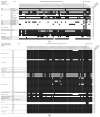Genetic and Phenotypic Virulence Potential of Non-O1/Non-O139 Vibrio cholerae Isolated from German Retail Seafood
- PMID: 38004762
- PMCID: PMC10672755
- DOI: 10.3390/microorganisms11112751
Genetic and Phenotypic Virulence Potential of Non-O1/Non-O139 Vibrio cholerae Isolated from German Retail Seafood
Abstract
Non-O1 and non-O139 Vibrio cholerae (NOVC) can cause gastrointestinal infections in humans. Contaminated food, especially seafood, is an important source of human infections. In this study, the virulence potential of 63 NOVC strains isolated from retail seafood were characterized at the genotypic and phenotypic levels. Although no strain encoded the cholera toxin (CTX) and the toxin-coregulated pilus (TCP), several virulence factors, including the HlyA hemolysin, the cholix toxin ChxA, the heat-stable enterotoxin Stn, and genes coding for the type 3 and type 6 secretion systems, were detected. All strains showed hemolytic activity against human and sheep erythrocytes: 90% (n = 57) formed a strong biofilm, 52% (n = 33) were highly motile at 37 °C, and only 8% (n = 5) and 14% (n = 9) could resist ≥60% and ≥40% human serum, respectively. Biofilm formation and toxin regulation genes were also detected. cgMLST analysis demonstrated that NOVC strains from seafood cluster with clinical NOVC strains. Antimicrobial susceptibility testing (AST) results in the identification of five strains that developed non-wildtype phenotypes (medium and resistant) against the substances of the classes of beta-lactams (including penicillin, carbapenem, and cephalosporin), polymyxins, and sulphonamides. The phenotypic resistance pattern could be partially attributed to the acquired resistance determinants identified via in silico analysis. Our results showed differences in the virulence potential of the analyzed NOVC isolated from retail seafood products, which may be considered for further pathogenicity evaluation and the risk assessment of NOVC isolates in future seafood monitoring.
Keywords: antimicrobial resistance; genetic and phenotypic characterization; non-O1/non-O139 Vibrio cholerae; seafood; virulence potential.
Conflict of interest statement
The authors declare no conflict of interest.
Figures



Similar articles
-
German coasts harbor non-O1/non-O139 Vibrio cholerae with clinical virulence gene profiles.Infect Genet Evol. 2024 Jun;120:105587. doi: 10.1016/j.meegid.2024.105587. Epub 2024 Mar 20. Infect Genet Evol. 2024. PMID: 38518953
-
Clinical and Environmental Vibrio cholerae Non-O1, Non-O139 Strains from Australia Have Similar Virulence and Antimicrobial Resistance Gene Profiles.Microbiol Spectr. 2023 Feb 14;11(1):e0263122. doi: 10.1128/spectrum.02631-22. Epub 2023 Jan 23. Microbiol Spectr. 2023. PMID: 36688638 Free PMC article.
-
Virulence and resistance patterns of Vibrio cholerae non-O1/non-O139 acquired in Germany and other European countries.Front Microbiol. 2023 Nov 22;14:1282135. doi: 10.3389/fmicb.2023.1282135. eCollection 2023. Front Microbiol. 2023. PMID: 38075873 Free PMC article.
-
Epidemiology & molecular biology of Vibrio cholerae O139 Bengal.Indian J Med Res. 1996 Jul;104:14-27. Indian J Med Res. 1996. PMID: 8783504 Review.
-
Non-O1/non-O139 Vibrio cholerae bacteraemia in mainland China from 2005 to 2019: clinical, epidemiological and genetic characteristics.Epidemiol Infect. 2020 Jul 8;148:e186. doi: 10.1017/S0950268820001545. Epidemiol Infect. 2020. PMID: 32635946 Free PMC article. Review.
Cited by
-
Bioinformatics combined with machine learning unravels differences among environmental, seafood, and clinical isolates of Vibrio parahaemolyticus.Front Microbiol. 2025 Mar 19;16:1549260. doi: 10.3389/fmicb.2025.1549260. eCollection 2025. Front Microbiol. 2025. PMID: 40177478 Free PMC article.
-
Septic shock caused by non-O1/non-O139 Vibrio cholerae: a case report.World J Emerg Med. 2025 Jul 1;16(4):395-397. doi: 10.5847/wjem.j.1920-8642.2025.069. World J Emerg Med. 2025. PMID: 40708735 Free PMC article. No abstract available.
-
Non-O1/O139 environmental Vibrio cholerae from Northern Cameroon reveals potential intra-/inter-continental transmissions.PLoS Negl Trop Dis. 2025 Apr 3;19(4):e0012890. doi: 10.1371/journal.pntd.0012890. eCollection 2025 Apr. PLoS Negl Trop Dis. 2025. PMID: 40179128 Free PMC article.
-
Non-O1/Non-O139 Vibrio cholerae-An Underestimated Foodborne Pathogen? An Overview of Its Virulence Genes and Regulatory Systems Involved in Pathogenesis.Microorganisms. 2024 Apr 18;12(4):818. doi: 10.3390/microorganisms12040818. Microorganisms. 2024. PMID: 38674762 Free PMC article. Review.
-
Public health aspects of Vibrio spp. related to the consumption of seafood in the EU.EFSA J. 2024 Jul 23;22(7):e8896. doi: 10.2903/j.efsa.2024.8896. eCollection 2024 Jul. EFSA J. 2024. PMID: 39045511 Free PMC article.
References
-
- Dalsgaard A., Albert M.J., Taylor D.N., Shimada T., Meza R., Serichantalergs O., Echeverria P. Characterization of Vibrio cgolerae non-O1 serogroups obtained from an outbreak of diarrhea in Lima, Peru. J. Clin. Microbiol. 1995;33:2715–2722. doi: 10.1128/jcm.33.10.2715-2722.1995. - DOI - PMC - PubMed
LinkOut - more resources
Full Text Sources

